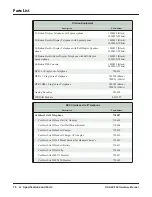
8
Multi-channel Systems
Artist Elite systems provide extensive monitoring and control
facilities. Transmitter data, in addition to being available at the
transmitter, is conveyed in digital form to and displayed on the
associated receiver.
Linked systems:
Both Artist Elite receivers provide linking jacks
and cables. AEW-R4100 and AEW-R5200 receivers may be
combined in linked multi-channel systems, if desired.
Ethernet-based monitoring and control (AEW-R5200):
Some
wireless systems on the market offer remote control/monitoring
of the receiver via a serial interface, but the Audio-Technica
AEW-R5200 receiver takes this a significant step further by
including control over IP using standard networking protocol and
Ethernet interfacing. This permits receivers in a system to be
integrated, monitored and controlled from a single computer in
real-time. And not only can an individual channel of an individual
receiver be examined and its settings modified: if the transmit-
ter on that channel is activated, thanks to the digital data link,
data from the associated transmitter can also be monitored.
Because standard control over IP is used, Ethernet-connected
AEW systems can range from a single laptop controlling a
free-standing multi-channel system, to local area network-based
systems, to systems controlled via the Internet, even from
great distances. Complete setup and operating information for
computer-connected AEW systems will be found in the separate
Computer Interface manual provided with AEW-R5200 receivers
and 5000 Series systems.
Transmitters
The versatile AEW-T1000 UniPak
™
body-pack transmitter
features a metal case and includes field-replaceable helical and
flexible-wire antennas. It has both low- and high-impedance
inputs plus a bias connection, for use with dynamic and electret
condenser microphones, as well as Hi-Z instrument pickups. In
addition to its programmable functions, the transmitter includes
a three-position sliding control cover to limit access, if desired,
to only the Power/Mute button, or to no controls at all, as
appropriate for the application and/or user.
The handheld microphone/transmitters feature metal-body
construction. Four models are available, incorporating a variety
of capsules from the Artist Elite wired-microphone series
created for professional live-sound venues.
All Artist Elite Series transmitters use two 1.5V AA batteries for
economical operation and wide availability. The receiver and
both transmitters have “fuel gauge” battery condition indicators
with low-battery warnings.
Please note that in multiple-system applications there must be a
transmitter-receiver combination set to a separate frequency for
each input desired (only one transmitter for each receiver).
Because the wireless frequencies are within UHF TV frequency
bands, only certain operating frequencies may be usable in a
particular geographic area. Also, only certain of the available
operating frequencies may be used together. Operating
frequencies and IntelliScan frequency groupings will be found
on pages 29-30. (Use of the IntelliScan channel assignment
system will determine and set appropriate frequencies
automatically.)
Receiver Installation
Location
For best operation the receiver should be at least 3 ft. (1 m)
above the ground and at least 3 ft. away from a wall or metal
surface to minimize reflections. The transmitter should be at
least 3 ft. from the receiver, as shown in Figure A. Keep
antennas away from noise sources such as digital equipment,
motors, automobiles and neon lights, as well as away from
large metal objects.
Output Connections
There are two audio outputs on the back panel: an XLR Mic
Output (25 mV) and a
1
/
4
" (6.3 mm) phone jack Instrument
Output (50 mV). The two isolated audio outputs permit
simultaneous feeds to two different inputs.
AEW-R4100:
This receiver offers a balanced XLR Mic jack and
an unbalanced Instrument
1
/
4
" TS phone jack. Output levels of
both are adjusted by the rear-panel Attenuator (ATTN) switch.
AEW-R5200:
Since there are two independent channels of
receiver in the AEW-R5200, there are two sets of output jacks.
All audio outputs on the AEW-R5200 are transformer-isolated
and balanced. The ground connections of both outputs on each
receiver channel may be interrupted (“lifted”) by use of their
associated Ground Lift switch. This permits feeding mixers
with different ground levels without an additional external split-
ter. The Instrument output is a balanced
1
/
4
" TRS jack with “audio
+” on the Tip, “audio –” on the Ring and ground (shield) on the
Sleeve. The rear-panel Attenuator (ATTN) switch for each
receiver channel adjusts levels of both outputs in its channel.
Use the appropriate shielded audio cable for connections
between the receiver and the input(s) of the mixer or other
equipment.
Antennas
Attach a pair of UHF antennas to the antenna input jacks. The
antennas are normally positioned in the shape of a “V” (both
45° from vertical) for best reception. In addition to rotating at
the connector, the included half-wave antennas pivot from
straight to right-angle.
Antennas can be remotely located from the receiver. However,
due to signal loss in cables at UHF frequencies, use the lowest-
loss RF cables practical for any cable runs over 25 feet. RG8-
type is a good choice. Use only copper-shielded cable, not
CATV-type foil-shielded wire. Audio-Technica offers auxiliary
antennas, and quality RF cables in four lengths; see the
Optional System Accessories section on page 28.
Antenna Power
The antenna input jacks also can p12V DC output on
their center pins to power inline RF devices. A maximum of 20
mA can be drawn from each of the jacks. While an accidental
short-circuit will not harm the internal 12V supply, make certain
that an antenna cable shield does not contact the center
conductor. Antenna Power (“
ANT.PWR
”) is selected (switched
on or off) from the LCD menu. (On the AEW-R5200, Antenna
Power will be found in the menu on Channel 1 only.)
Figure A








































